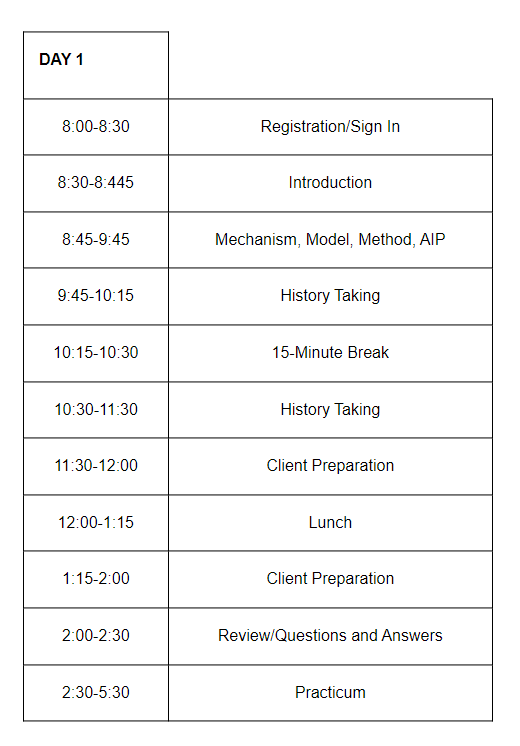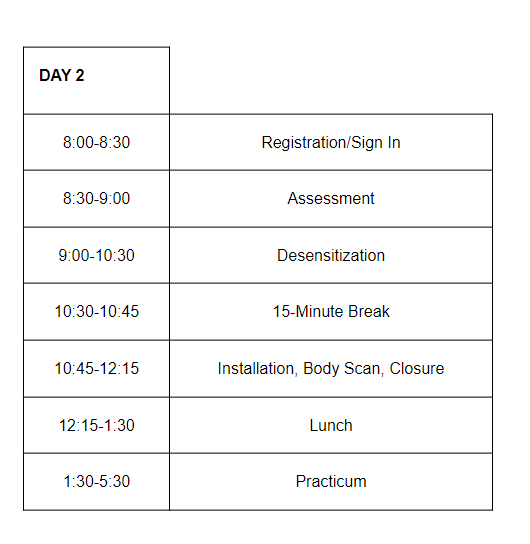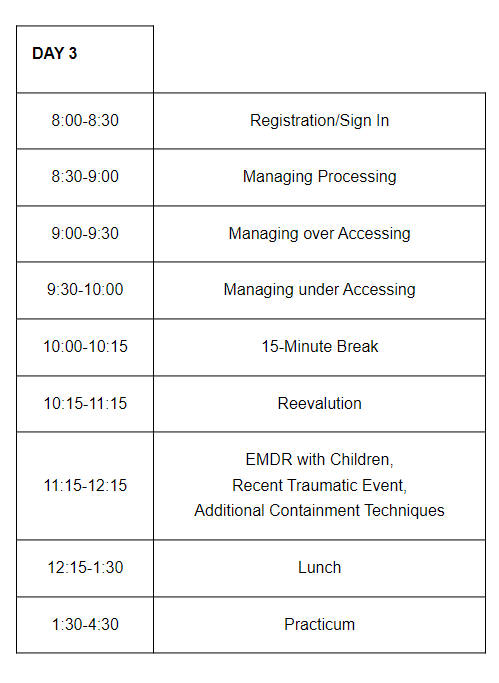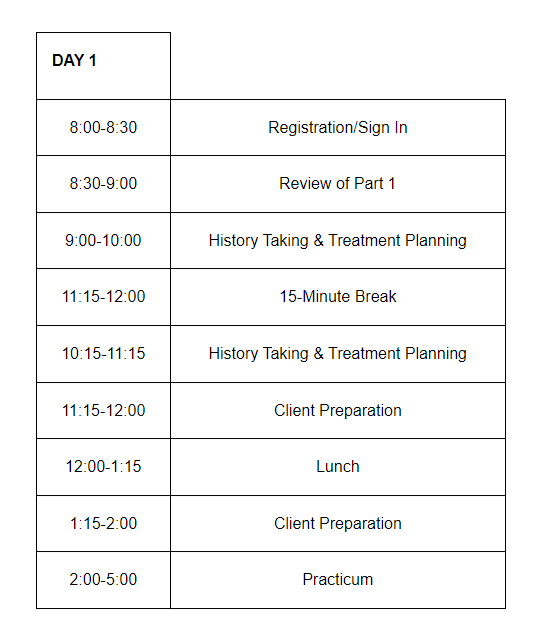course overview
An Overview of Our EMDR Training Program
This course has been approved by the EMDR International Association (EMDRIA). This is important as there are courses being offered which do not meet the credentialing established by EMDRIA. Consequently, those courses do not teach what has been determined to be necessary for the student to master EMDR. EMDRIA-approved courses are located on EMDRIA’s website. Go to emdria.org and look under training and certification.
In addition, when taking an EMDRIA-approved course, you are eligible to receive consultation from an approved consultant. You will also be able to work toward certification in EMDR and attend specialized training and conferences. Without an EMDRIA-approved course, you will not be eligible for these benefits. However, what is most important is that you learn EMDR in a way that will help you utilize it properly and effectively. Consequently, you will have more success with your clients which is the most important learning objective.
Students may be concerned about remembering all that is taught in the 3-day courses. The manual that you will receive as part of the course has been written in such a way that it will guide you step-by-step through each phase of the EMDR Training Course.
All students are required to obtain the textbook "Eye Movement Desensitization and Reprocessing: Basic Principles, Protocols, and Procedures," by Francine Shapiro, Ph.D. For Part 1, chapters 1–8 should have been read before the training. For Part 2, chapters 9–11 should have been read.
The course manual will be sent electronically upon completion of registration and payment.
Basic Training Hours
This course is taught in 2 parts. Students will complete 50 hours of education while learning EMDR.
Part 1 consists of 10 hours of lecture, 10 hours of supervised practice exercises, and 5 hours of consultation. Part 2 consists of the same number of hours for a total of 50 hours.
EMDR Training Part 1
Part 1 Course Objectives
- The participant will be able to describe concepts of the adaptive information processing model (AIP) and its relevance to EMDR.
- The participant will be able to explain that memories are the targets for EMDR therapy and reprocessing.
- The participant will be able to summarize how to take a history and develop and EMDR treatment plan.
- The participant will be able to explain the techniques for stabilizing clients for phase 2 of EMDR Therapy.
- The participant will be able to demonstrate the application of phase 3, assessment.
- The participant will be able to explain phase 4 desensitization.
- The participant will demonstrate how to conduct phase 5 Installation.
- The participant will be able to demonstrate phase 6 body scan.
- The participant will conduct phase 7 closure.
- The participant will be able to explain phase 8 reevaluation.
- The participant will be able to summarize the three-pronged approach of EMDR.
- The participant will be able to explain the application of EMDR in the treatment of children.
- The participant will be able to summarize recent event protocols for EMDR.
Part 1 Outline
The goal of the first part is to familiarize the client with the basics of the EMDR procedural steps and protocol. Through this instruction, the student will obtain the necessary knowledge and skills to begin the use of EMDR in his/her practice.
Day 1
- Introduction to the Origins and Development of EMDR.
- Instruction on the Adaptive Information Processing (AIP) Model
- Instruction on Phase 1: History of EMDR & Phase 2: Client Preparation
- Practice exercise in developing the skills for History Taking in Client Preparation.
- Approximately 4-Hours’ Lecture and 3-Hours’ Practice Training Exercises.

Day 2
- Complete instruction on Phases 3-7: Assessment, Desensitization, Installation, Body Scan, & Closure.
- Practice exercises with Processing a Memory with Phases 3–7. Approximately 3.5 Hours

Day 3
- Instruction on managing processing, processing current triggers, and future concerns, the protocol for the future template, EMDR with children, as well as the protocol for recent traumatic events, and additional containment skills. Approximately 3.5 Hours
- Practice exercises re-evaluation of processed memory, processing additional relevant memories, current triggers, and future templates. Approximately 3.5 Hours.

EMDR Training Part 2
Part 2 Course Objectives
The participant will be able to describe concepts of the adaptive information processing model (AIP) and its relevance to EMDR.
1. The participant will be able to explain the adaptive information processing model (AIP) and its relevance to EMDR.
2. The participant will be able to explain of the 8 phases of EMDR therapy
3. The participant will be able to demonstrate the fundamentals of three-pronged-protocol related to an EMDR treatment plan.
4. The participant will recognize complex cases and be able to prepare the client for EMDR therapy.
5. The participant will be able to demonstrate the use of the cognitive interweave as it applies to EMDR desensitization.
6. The participant will be able to recognize symptoms or complex PTSD and dissociation.
7. The participant will be able to demonstrate EMDR with phobic disorders.
8. The participant will be able to describe the application of the grief protocols for EMDR.
9. The participant will be able to explain the application of EMDR to illnesses and somatic disorders.
10. The participant will be able to explain the application of EMDR to treating combat veterans.
11. The participant will be able to demonstrate the use of EMDR for addictions.
12. The participant will be able to summarize the use of EMDR and treating personality disorders.
13. The participant will be able to explain EMDR in the treatment of borderline personality disorder.
Part 2 Outline
The goal of the second part is to review the basic EMDR protocols and procedures taught in Part 1. In addition, the second part will develop methods of treating more complex cases. This includes the development of treatment plans for complex cases, dynamics of trauma, and use of the cognitive interweave.
Day 1
- Review of the 8 EMDR phases, AIP, and the 3 stages of treatment past, present, and future.
- History taking, phase 1, with complex cases as well as client preparation.
- Resource Development and Installation (RDI). Lecture approximately 4 hours.
- Practice exercises taking history, client preparation, and RDI. Approximately 3 hours.
- Approximately 4-Hours’ Lecture and 3-Hours’ Practice Training Exercises.

Day 2
- Use of phases 3–8 with more complex presentations and managing abreactions as well as over and under accessing during desensitization.
- Instructions on the cognitive interweave. Lecture approximately 3.5 hours.
- Practice exercises with processing a memory using phases 3–7. Exercises approximately 4 hours.

Day 3
- Instruction on obstacles related to processing, dissociation, treating specific situations such as phobias, illness and somatic disorders, self-use of eye movements, grief, adults abused as children and sexual abuse, couples, and combat and first responders. Approximately 3.5 hours.
- Practice exercises for completing EMDR treatment plan: past, present, and future. Approximately 3.5 hours.

Steps to Get Started
01. Check Eligibility
Check to see if you meet the minimum requirements for our EMDR Therapy Training Courses at EMDR Instruction.
02. Register
Reserve your Course Registration for our Upcoming EMDR Training Course at EMDR Instruction by clicking here.
03. Pay
Once you have completed your Course Registrations, you will be redirected to make your Course Payments for Part 1 and Part 2 of the EMDR Training Courses.
New Parag
820 Jordan St Ste 570
Shreveport, LA
71101
Copyright © Center for Psychological Trauma | All Rights Reserved
820 Jordan St Ste 570
Shreveport, LA
71101


